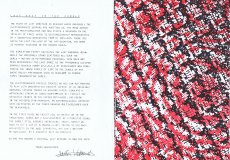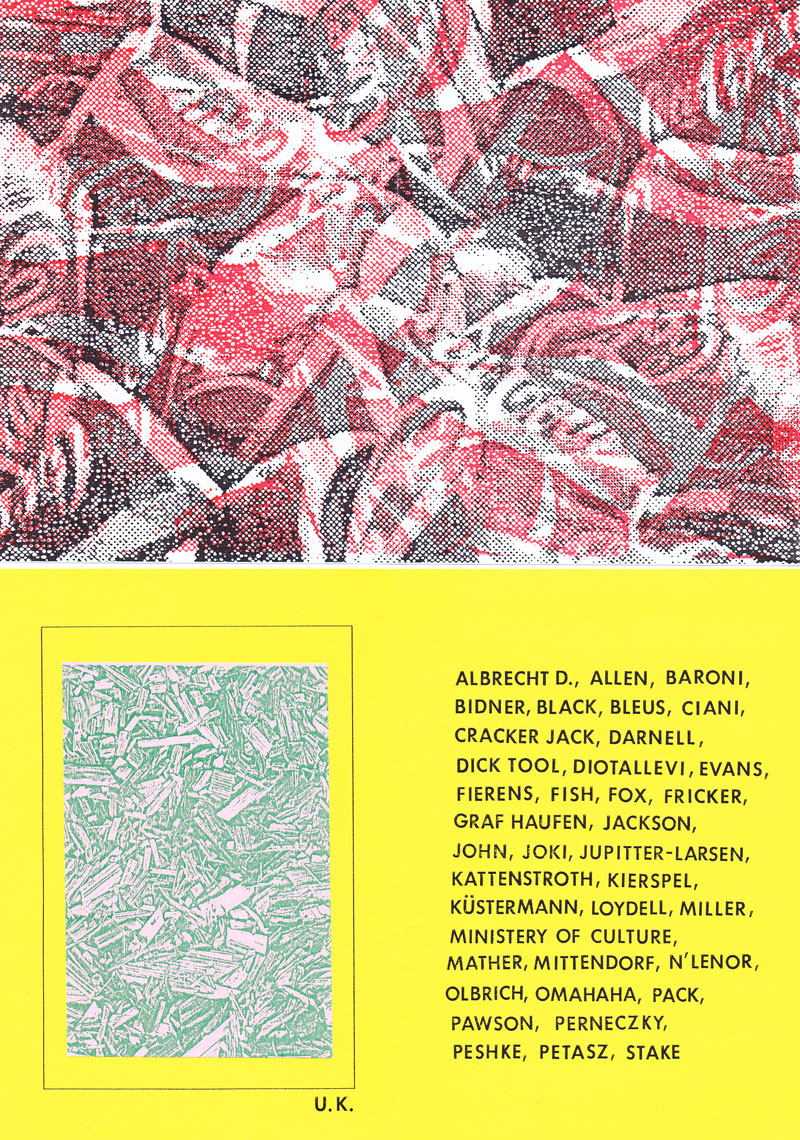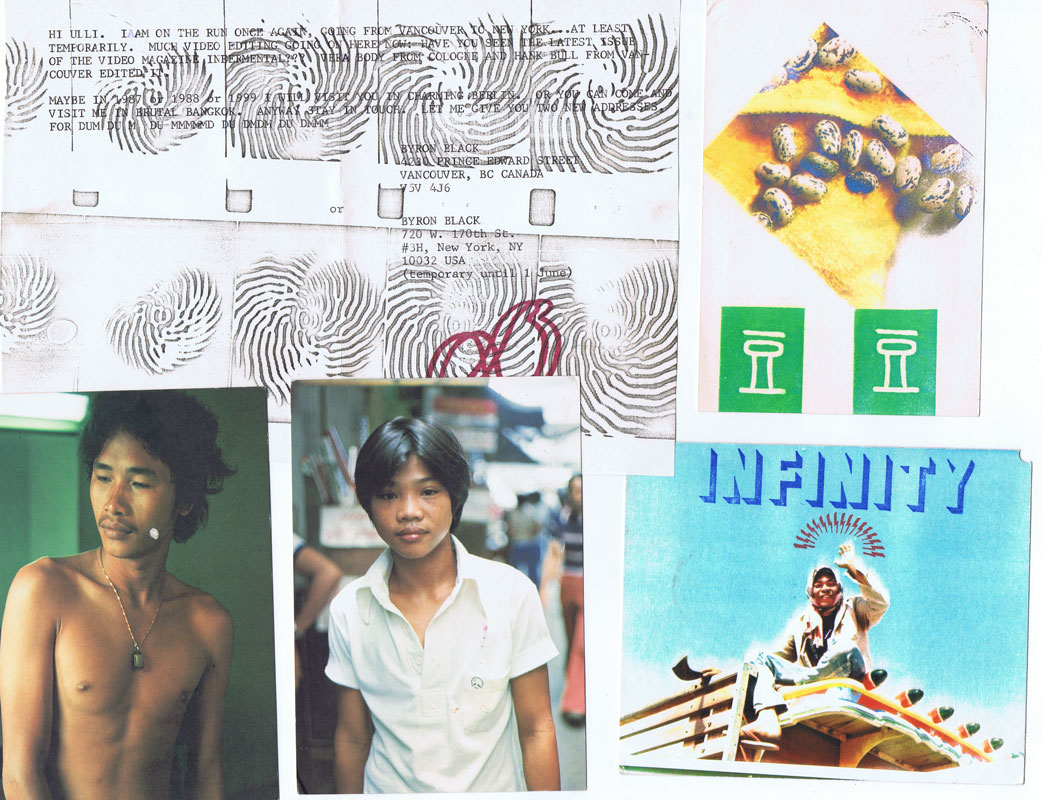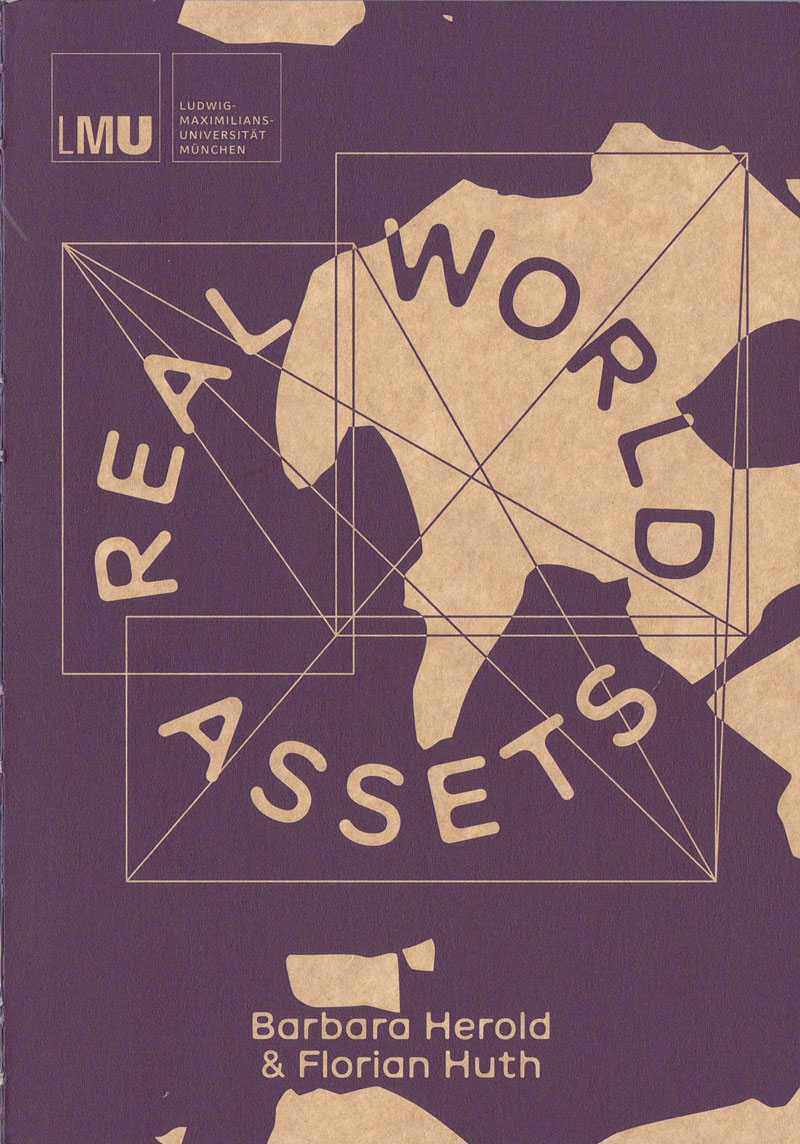|
Titel
-
1946-1976 - In the Jungle of Art
Technische
Angaben
-
90 S., 29,7x21 cm, 2 Stück. keine weiteren Angaben vorhanden
Broschur
|
Technische
Angaben
-
Auflage: 1.500, keine weiteren Angaben vorhanden
bern's magazin für hip-hop, jungle und andere lebenswichtige angelegenheiten
|
Technische
Angaben
-
13x13 cm, keine weiteren Angaben vorhanden
Musik-CD in gefalteter Papphülle und transparenter Kunststoffhülle
ZusatzInfos
-
"My compositions have no concept. That's my concept. I just see them as a tool that stirs up the minds or consciousness of the people listening. I've never felt that a performer did injustice to my pieces, for a composition only comes to life in the particular context, the combination of the performer and the atmosphere of the public. I like to compose not only for instruments, but for "things" as well. Sound of things can be surprising, especially their artificial sound. For example, without looking, one would never guess that my tapping and dragging fingers across the surface of a cigar box that is connected to a laptop for what it is." (Tetsuya Hori)
|
Titel
-
1946-1976 - In the Jungle of Art
Technische
Angaben
-
90 S., 29,7x21 cm, 2 Stück. keine weiteren Angaben vorhanden
Broschur
ZusatzInfos
-
Blaue Coverversion. Englische Übersetzung von Henry Martin
|
Technische
Angaben
-
8 S., 10,6x7,5 cm, numeriert, keine weiteren Angaben vorhanden
mehrfach gefaltetes und beidseitig bedrucktes Einzelblatt, Farblaserkopie auf gelben Papier, geschnitten
|
Technische
Angaben
-
108 S., 24x17 cm, Auflage: 500, ISBN/ISSN 9783945337028
Broschur, Eingelegt ein A4-Blatt mit Infos zum Buch
ZusatzInfos
-
Publiziert anläßlich der Debütantenausstellung 2014 im BBK München.
Ooze ist der Modder, der Schlick und Schlamm in dem wir alle stecken, mit dem wir uns aber auch gerne rumschlagen und in dem wir gerne wühlen: 3d-Waste, Theoriebausteine, Musikvideos, Shots einsamer Art-Installations, alltägliches Nebenher, Bildschirme, Drucker, Artificial Intuition, mehr Material, Textfragmente, (echte) Erinnerungen, Rauschen, neue Entdeckungen, immer mehr Technologiegadgets und mehr oder weniger spektakuläre Effekte, Buch- und Magazinseiten, verschiedene Fonts, anderer Stuff (Kram).
Text zum Buch von der Webseite
|
Technische
Angaben
-
21x16,5 cm, Auflage: 50, numeriert, 2 Stück. ISBN/ISSN 9783928804660
Hülle in transparenter Kunststoffhülle mit individuellem Textblatt, in mit gelbgrünem Faden handgenähter brauner Papiertüte (unterschiedliche Formate) mit original Stempeldrucken und handnummeriert
ZusatzInfos
-
Herausgegeben von TAM TAM anlässlich dem Ende der Zwischennutzung der Pappschachtel am Pasinger Marienplatz durch TAM TAM FloStern, Münchner und internationale Künstler.
Schlagerhygiene (Sanctus Carlus Barricadus), Panic Girl (Breeze), Pacifico Boy (Am Tag bevor der Euro kam (Flo* Edit)), The Hercules and Leo Case (Jungle), Belp (Bewonk), sec2nd (the sum), Muftak Robotu (Kringelgebäck), Trash Why (I Got NEWs), Pille Sardelle (Paranoidenschwarm), mycrotom (mumiru), Gottfried Weber-Jobe (analog2), BUG (Sediment), andcl (1929 1715), Toshio Kusaba (Vocals JP), Sarah Ines (Lyrics, Vocals DE), Peter Arun Pfaff (fukushima sakura)
|
Technische
Angaben
-
32 S., 21,5x14,5 cm, Auflage: 500, ISBN/ISSN 20566301
Drahtheftung,
ZusatzInfos
-
Mit: A Downland Index by Angus Carlyle, TCP by Les Coleman, Aggregate by Colin Sackett, Hashkerville by Stuart Mugridge, Artificial Rubbish Heap by John Bevis, Journey-Book by Michael Gibbs, Some Ironmongery by Erica Van Horn, Why Listen to Museums? by John Kannenberg, A Little Chantr’y for Spring by Stephen Duncalf, TCP by Les Coleman, Book Things by Jeremy Cooper, Google Landscapes by Tom Wilkinson
|
Titel
-
MONO.KULTUR #36 Ricardo Bofill - The Future of the Past
Technische
Angaben
-
48 S., 20x15 cm, ISBN/ISSN 18617085
Drahtheftung, gedruckt auf verschiedenen Papieren
ZusatzInfos
-
where to begin with an architect as over the top as Ricardo Bofill, notorious since the 1970s for his vast city-like housing estates that look like surreal experiments in crossbreeding desert caves with Star Wars. an architect who has designed over 1000 projects in the space of five decades, from perfume bottles to city plans, and pretty much everything in between. who has worked in a style – or a hundred styles – that is as unique as it is impossible to describe. who founded a leftist collective that would eventually end up building airport terminals. whose life reads somewhat like a fairytale itself, taking us from fascist Spain under Franco’s rule to the celebrity frenzy of our modern times, with the Bofill clan holding a somewhat unique position among Spanish tabloids? To add any more is to inevitably leave out too much. With mono.kultur, Ricardo Bofill talked about fifty years of architecture, the vagaries of ambition and how Modernism killed the city. Visually, the issue offers a disorienting journey of architectural splendour with plenty of previously unpublished images from the archives of Ricardo Bofill (as well as the odd film still of naked bodies). Using partial high gloss varnish throughout, it is a pleasing juxtaposition of the natural and the artificial, the intellectual and the sexual, the disciplined and the decadent.
Text von der Website.
|
Titel
-
MONO.KULTUR #44 Trevor Paglen - The Edge of Tomorrow
Technische
Angaben
-
24 S., 20x15 cm, ISBN/ISSN 18617085
Drahtheftung, sechs Blätter, gefaltet, in Antistatiktasche
ZusatzInfos
-
Best known for his series on clandestine military bases and spy satellites, Trevor Paglen’s practice reaches far beyond museum walls. Instead, it encompasses a variety of disciplines. from image-making and installations to investigative journalism, writing, engineering, geography, and sound design. Along the way, Paglen challenges our traditional notions of fine art. He has published a number of books on the functioning of the US intelligence services, installed a series of Autonomy Cubes that allow access to the entirely anonymous Tor network, and is currently working on his own satellite to be launched into space in summer 2018. In a sweeping conversation with mono.kultur, Trevor Paglen talked about the volatility of truth, the dilemmas of the Anthropocene, and why Artificial Intelligence will not outlast humanity. True to its precious content, the issue comes in a Static Shielding Bag normally used for sensitive electronic products. In loose reference to computer coding as well as archival documents, it contains a main booklet with the text and excerpts from Paglen’s current cycle on machine vision, as well as six ‘attachments’ covering seminal projects from his career to date.
Text von der Website.
|
Technische
Angaben
-
[2] S., 42x29,7 cm, 2 Stück. ISBN/ISSN 9783928804660
farbig handbedruckte CD in raffiniert gefaltete Farblasercopie
ZusatzInfos
-
Herausgegeben von TAM TAM, ursprünglich anlässlich dem Ende der Zwischennutzung der Pappschachtel am Pasinger Marienplatz durch TAM TAM FloStern, Münchner und internationale Künstler.
2. Auflage limitierte Edition für Kunst im Karree 2016,09. und 10.07.2017 beim Tag der Offenen Tür im TAM TAM Atelier in der Türkenstraße 60 UG mit Atemlose Sozialcocktailrisikoemotionen in Pink von Rohbart Ratford, Bilder von El Rago, Soundinstallation und Lichtinstallation von Matt-Hias Startklar
Schlagerhygiene (Sanctus Carlus Barricadus), Panic Girl (Breeze), Pacifico Boy (Am Tag bevor der Euro kam (Flo* Edit)), The Hercules and Leo Case (Jungle), Belp (Bewonk), sec2nd (the sum), Muftak Robotu (Kringelgebäck), Trash Why (I Got NEWs), Pille Sardelle (Paranoidenschwarm), mycrotom (mumiru), Gottfried Weber-Jobe (analog2), BUG (Sediment), andcl (1929 1715), Toshio Kusaba (Vocals JP), Sarah Ines (Lyrics, Vocals DE), Peter Arun Pfaff (fukushima sakura)
|
Titel
-
Fotografija NR. 1 (35) 2018
Technische
Angaben
-
[116] S., 27,5x23 cm, ISBN/ISSN 16487273
Broschur
ZusatzInfos
-
We are heading into a future where our choices will be shaped – if not outright determined – by algorithms and artificial intelligence. This coming state has been labelled “the new dark age” (James Bridle, 2018).
It remains to be seen what this brings to photography, and vice versa.
One thing, however, seems clear: photography, which has already changed significantly in the 21st century, is affected by – and in some important ways is part of – this development. This issue of “Fotografija” explores how programmes, apps and AI-related technologies shape and change the discourse of photography, challenging traditional boundaries of the medium.
Various programmes and services – Google, Photoshop, Flickr, Snapchat, visual recognition, etc. – provide new tools to conceive image-making and think photographically. Technological interfaces not only deliver instruments for making work but can become the very logic for creating photographic series.
The presented artists offer perspectives to raise questions and discuss these technological shifts. From dealing with traumatic events (Indrė Šerpytytė) and inaccessible sites (James Bridle) through technological mediation to playing with our expectations of an all-pervasive Photoshop manipulation (Erin E’Keefe). From exploring so-called smart surveillance systems (Esther Hovers) and censoring politically sensitive sites (Mishka Henner) to everyday glitches (Mantas Grigaitis). From playing with the copyrights of such collective websites as Flickr (Penelope Umbrico) to exploring the shared language of being in some of the most photographed places on earth (Thomas Albdorf). And from using Photoshop to create images (Aaron Hegert) to an image that is barely photographic (Zachary Dean Norman). The four essays (Kate Palmer Albers, Roksana Filipowska and Marijana Rayl, Ilaria Speri, Alise Tifentale) map out the works in broader social, historical and art contexts.
In short, the works deal with our technologized world. They talk about being in the middle of changes that few have envisioned. Being so immersed, one can feel it (almost) hurts.
Text von Paul Paper.
|
Technische
Angaben
-
[72] S., 30x22 cm, signiert, ISBN/ISSN 9782350461977
Fadenheftung, Klappumschlag, mit Widmung
ZusatzInfos
-
Teufelsberg (mountain devil), is an artificial hill located southwest of Berlin, overlooking the city. Amusement park very popular with young Berliners, this hill was built after the Second World War with the remnants of the city after the Allied bombing. An estimated 30 million cubic meters of rubble piled mass there, the equivalent of 400,000 buildings. The hill rises on the site of the University of Nazi war which had been designed by the architect of the Third Reich, Albert Speer, and half done. As after the war, it was difficult to totally destroy the building riddled with underground bunkers, the German authorities decided to bury him and make him disappear under an artificial hill. The hill was then covered with trees, and used during the winter ski run in the 60s and 70s. During the Cold War, was built at the top center of U.S. espionage radar to listen to communications of the Soviet bloc in East Berlin.
Text von der Webseite
|
Technische
Angaben
-
48 S., 27,6x22,2 cm, Auflage: 1.000, 2 Teile. keine weiteren Angaben vorhanden
Zeitung, Drahtheftung, Aufkleber mit Illustrationen von Carmen Reina auf einem Din A 5 Bogen beiliegend, mit Postkartengruß von Pia Lobodzinski an Hubert Kretschmer beiliegend
ZusatzInfos
-
... bringen in Essays, Artikeln und poetischen Texten die ganze mediale Vielfalt der Jagd zur Strecke. Angefangen mit Jagd-Gründen und Weisheitsjägern in (spät-)mittelalterlichen Erzählungen über mordlüsterne Streichinstrumente in zeitgenössischer Musik und revoltierenden Jägerinnen in der Popkultur – unsere No. 8 zeigt, warum Jagd mehr als nur eine Praxis ist: G.A. Beckmann führt in seinem Dramolett die Jagd maliziös als elitäres Hobby vor, wenn er den Kyny auf All-Inclusive-Reise durch Sissiland jagen lässt. Anhand des Dokumentarfilms Safari macht Laura Beck die (post-)koloniale Dimension der Trophäenjagd sichtbar, und Shannon Ray erklärt, was Jagd mit Umweltschutz zu tun hat. Es werden amerikanische Jungle-Comics und deutsche Jagdzeitungen analysiert, kanonische Texte von Kafka bis Musil aufs Korn genommen und verflossenen Jahren wie Wörtern hinterhergejagt …
Text von der Webseite
|
Technische
Angaben
-
205 S., 13x20,5 cm, ISBN/ISSN 9781913824020
Fadenheftung, Soft-Cover, "Meatspace Press"-Sticker (silbern)
ZusatzInfos
-
Von der Vorhersage von Kriminalität bis hin zur sexuellen Orientierung - gefälschte und zutiefst fehlerhafte KI ist weit verbreitet. Inmitten dieser fieberhaften Hype-Atmosphäre hinterfragt dieses Buch den Aufstieg und Fall von KI-Hype, Pseudowissenschaft und snake oil.Es bringt verschiedene Perspektiven und Stimmen aus unterschiedlichen Disziplinen und Ländern zusammen und stellt Verbindungen zwischen den Ungerechtigkeiten her, die durch unangemessene KI verursacht werden.
Jedes Kapitel packt faule und schädliche Annahmen aus, die von Entwicklern bei der Konzeption von KI-Tools und -Systemen gemacht werden, und untersucht die existenziellen Grundlagen der Technologie selbst, um zu fragen: Warum gibt es so viele nutzlose und sogar gefährlich fehlerhafte KI-Systeme?
Klappentext, mit DeepL übersetzt
Die Problematik von Künstlicher Intelligenz (KI) wird in 16 Kapiteln von unterschiedlichen Blickwinkeln beleuchtet:
Kapitel 1: This book is an intervention
Kapitel 2: AI Snake Oil, Pseudoscience and Hype
Kapitel 3: Cheap AI
Kapitel 4: The bodies underneath the rubble
Kapitel 5: Who am I as data?
Kapitel 6: The case for interpretive techniques in machine learning
Kapitel 7: Do we need AI or do we need Black feminisms? A poetic guide
Kapitel 8: How (not) to blog about an intelligent toothbrush
Kapitel 9: Learn to take on the ceiling
Kapitel 10: Uses (and abuses) of hype
Kapitel 11: Talking heads
Kapitel 12: What is a face?
Kapitel 13: Why automated content moderation won’t save us
Kapitel 14: Consolidating power in the name of progress: techno-solutionism and farmer protests in India
Kapitel 15: When fintech meets 60 million unbanked citizens
Kapitel 16: Algorithmic registers and their limitations as a governance practice
The power of resistance: from plutonium rods to silicon chips
|
Titel
-
spex - 2014 Nr. 351, 352, 353, 354, 355, 356, 357
Technische
Angaben
-
28x23 cm, 7 Teile. keine weiteren Angaben vorhanden
Klebebindung, Werbeanzeigen enthalten
ZusatzInfos
-
Magazin für Pop-Kultur. 6 Ausgaben pro Jahr.
|
Technische
Angaben
-
136 S., 20,3x10,7 cm, keine weiteren Angaben vorhanden
Hardcover, Fadenheftung
ZusatzInfos
-
In Dream Villa erkundet Singh, wie die Nacht das, was am Tag gewöhnlich erscheint, in etwas Geheimnisvolles und Beunruhigendes verwandelt. Diese Serie von Farbfotografien zeigt eine Landschaft, die ebenso in der Vorstellung des Künstlers wie in der realen Welt existiert. Singh reist in viele verschiedene Städte, ohne zu wissen, wo die Dream Villa oder ihre Bewohner auftauchen werden. Es ist ein Ort, an dem nichts so ist, wie es zu sein scheint - er erwacht in der Nacht zum Leben, wenn alles von künstlichem Licht erhellt wird und der Mond nur noch ein Ornament ist.
In Dream Villa Singh explores how the night transforms what seems ordinary by day into something mysterious and unsettling. This series of colour photographs presents a landscape which exists as much in the artist’s imagination as in the real world. Singh travels to many different cities never knowing where Dream Villa or its inhabitants will present themselves. It is a place where nothing is quite as it seems to be – it comes alive at night, when all is lit by artificial light and the moon is just ornamentation.
Text von der Webseite
Übersetzt mit Deepl
|
Titel
-
Ohne Notizen geht es nicht
Technische
Angaben
-
4 S., 29,5x20,8 cm, 2 Stück. keine weiteren Angaben vorhanden
Farblaserdruck gefaltet
ZusatzInfos
-
Gespräch zwischen Tobias Premper und Martin Lechner über die Bedeutung des Einfalls beim Schreiben, publiziert in der Jungle World am 20.05.2020
|
Titel
-
Strategien der Aufstandsbekämpfung - Counterinsurgency Strategies
Technische
Angaben
-
[12] S., 21x14,8 cm, signiert, 5 Teile. keine weiteren Angaben vorhanden
Drahtheftung, Karte mit handschriftlichem Gruß beigelegt
ZusatzInfos
-
Challenge: Mapping New Relations Between Art, War and Society
Madrid - SdA Innovation Challenge, Spring, 2025
Can you solve it?
How to Differentiate Between Art and Cognitive Warfare?
On the one hand, art is weaponized and securitized; on the other, warfare is producing new models of inescapable reality enhanced in cognitive and artificial ways. What concept of art could be separated from war? Or, if that is not even the purpose anymore, how does one distinguish weaponized art that is friendly from art that is hostile?
Friday, January 17, 2025, 6--9 pm Information event
Saturday, February 22, 2025, 5-9 pm Pilehing event
Herausforderung: Kartierung neuer Beziehungen zwischen Kunst, Krieg und Gesellschaft
Madrid - SdA-Innovationswettbewerb, Frühjahr, 2025
Können Sie die Aufgabe lösen?
Wie kann man zwischen Kunst und und kognitiver Kriegsführung unterscheiden?
Auf der einen Seite wird die Kunst bewaffnet und abgesichert, auf der anderen Seite produziert die Kriegsführung neue Modelle einer unausweichlichen Realität, die auf kognitive und künstliche Weise verbessert werden. Welcher Begriff von Kunst könnte vom Krieg getrennt werden? Oder, wenn das nicht einmal mehr der Zweck ist, wie unterscheidet man dann bewaffnete Kunst, die freundlich ist, von Kunst, die feindlich ist?
Freitag, 17.01.2025, 18 bis 21 Uhr Informationsveranstaltung
Samstag, 22.02.2025, 17-19 Uhr Pitching-Veranstaltung
Übersetzt mit DeepL
|
Titel
-
The Jungle Of Art - Documentation
Technische
Angaben
-
5 Teile. keine weiteren Angaben vorhanden
Aus dem Kattenstroth Konvolut.
ZusatzInfos
-
• Umschlag beklebt mit farbigem Inkjet Druck, Adressstempel, 16,2x22,8cm
• DINA5 Klappkarte "The Jungle Of Art", gelbes Tonpapier, Schwarz-Weiß Xerox, farbiger Xerox, Artcore-Gallery, Berlin, 02.08.-10.08.1986
• DINA4 Kopie Schwarz-Weiß, einfach gefaltet, Text "Last Exit In The Jungle"
• 2 DINA4 Xerox in Schwarz und Rot, einfach gefaltet, rückseitig jeweils Adressstempel
|
Titel
-
Kattenstroth Konvolut - Gerald Jupitter-Larsen
Technische
Angaben
-
15 Teile. keine weiteren Angaben vorhanden
ZusatzInfos
-
• A4 Schwarz-Weiß Kopie "BOMBS IN THE SEA! - A RADIO PERFORMANCE" 10.01.1984
• Programm der Newsounds Gallery, aufgeklebt auf gelbes Tonpapier, "Archive: Metal-Work; and a 4 hour sound sculpture by Jupitter-Larsen entitled Sculptitory Shreds", August 1984
• Heft "a basic introduction to the t.n.u.", 8 Seiten, Drahtheftung, 21,7x17,7cm, Schwarz-Weiß Xerox mit Illustrationen, 1985
• Heft "CONCEPTOLOGY: fractionating concepts", 12 Seiten, Drahtheftung, 12,5x13,8cm, 1985
• 3 Postkarten "NO Government NO Anarchy", Schwarz-Weiß Grafiken/ Illustrationen, beklebt mit Xerox und Farbkopien
• Postkarte Schwarz-Weiß Grafik
• Postkarte beklebt mit Schwarz-Weiß Grafik Xerox
• Postkarte beklebt mit bestempelter Visitenkarte
• Schwarz-Weiß Xerox Text mit Illustrationen "...don't mention it Marcus Sarjeant..."
• Farb Xerox, 27,9x21,6, einmal gefaltet
• Farb Xerox, 20x20cm
• Brief an Kattenstroth, Künstlerbriefmarke Farb-Xerox; 21,3x16cm Farb-Xerox, rückseitig handschriftliche Notiz "For The Jungle Of Art"
G. X. Jupitter-Larsen wurde 1959 in Denver, Colorado, geboren. In den späten 1970er Jahre zog er nach Vancouver, Kanada. Dort begann er seine Aktivitäten in dem Mail Art Network und anderen Underground-Szenen. Er war beteiligt an Punk-Rock-, Kassetten- und Zine-Kultur sowie an der koordinierten Pawel Petasz' Commonpress Editions während der Zeit des polnischen Kriegsrechts von 1981 bis 1989. Bei seinen Auftritten ist er für seinen Nihilismus bekannt, als Gründer von The Haters, praktizierte er live Hardcore-Noise und brachte Noise-Musik auf über 300 Platten und CDs heraus. Bei seinen Auftritten (oft mit einer Gummimaske) arbeitete er mit einem Winkelschleifer an Gummireifen, die über dem Publikum hingen. In den 1990er Jahren arbeitete er als Sounddesigner für Mark Paulines Survival Research Laboratories. Er drehte Filme und Videoarbeiten, veröffentlichte drei Romane und produzierte viele Stunden Radio. G. X. Jupitter-Larsen lebt heute in Hollywood, Kalifornien.
Text von der Website des Lomholt Mail Art Archive, übersetzt mit DeepL
|
Titel
-
Kattenstroth Konvolut - Byron Black
Technische
Angaben
-
9 Teile. keine weiteren Angaben vorhanden
ZusatzInfos
-
• Postkarte, adressiert an Kattenstroth, Nachricht, Collagiertes Fotomotiv, Poststempel 1987
• Postkarte, adressiert an Kattenstroth, Stempel, Künstlerstempel, Nachricht, Fotomotiv fotografiert vom Künstler
• Postkarte, adressiert an Kattenstroth, Stempel, Künstlerstempel, Fotomotiv fotografiert vom Künstler
• Schwarz-Weiß Portrait des Künstlers
• Postkarte, adressiert an Kattenstroth, Stempel, Künstlerstempel, handschriftliche Nachricht, Poststempel
• Schwarz Weiß Kopie Grafik, Nachricht an Kattenstroth mit Schreibmaschine
• Brief ohne Inhalt, adressiert an Kattenstroth, Stempel, Künstlerstempel
• Postkarte, adressiert an Kattenstroth, Stempel, Künstlerstempel, handschriftliche Nachricht
• A4 Schwarz-Weiß Xerox "Totalartaryan Manifesto", Einsendung zu "Jungle of Art" von Ulli Kattenstroth
Byron Black (Baron Infinity) arbeitete in den 1970er Jahren in Vancouver mit Film, Video und Mail Art.
Vancouver in den 1970er Jahren. Er moderierte und produzierte Images from Infinity, eine serielle Kunst-Fernsehsendung auf Cable 10. Im Jahr 1980 ging er ging er nach Südostasien. Eine unregelmäßige Spur von transnationalen Depeschen zeichnet seine Reisen durch Myanmar, Japan, Thailand und Indonesien nach.
Text von der Website, übersetzt mit DeepL
|
Titel
-
Barbara Herold & Florian Huth - Real World Assets
Technische
Angaben
-
72 S., 21x14,7 cm, Auflage: 600, 2 Stück. ISBN/ISSN 978-3-68919-064-4
Offener Rücken, Fadenheftung
ZusatzInfos
-
Publikation zur Ausstellung 15.05.-31.07.2025 im CAS LMU.
Das Künstler*innenduo Barbara Herold und Florian Huth erforscht seit 2013 das Spannungsfeld zwischen Natur und Künstlichkeit. Ihre Arbeiten hinterfragen Konzepte von Authentizität, Simulation und Fake in einer zunehmend digitalen, postnaturalen Welt. Sie zeigen grafische Serien aus dem Werkkomplex Real World Assets. Mithilfe von Vermessungs- und Bestandsaufnahmeverfahren verbinden sie dokumentarische Präzision mit einer experimentellen Bildsprache und loten so die Grenzen zwischen wissenschaftlicher Erfassung und künstlerischer Interpretation aus.
Text von der Webseite
|




























































